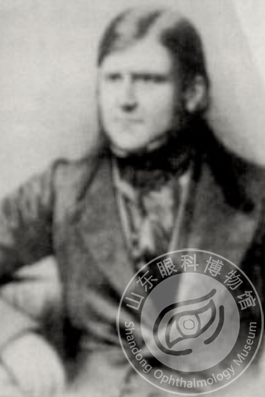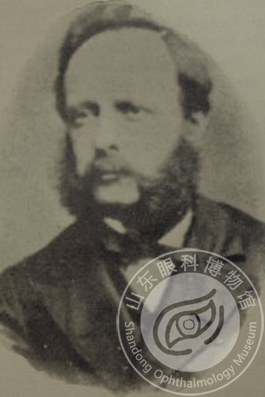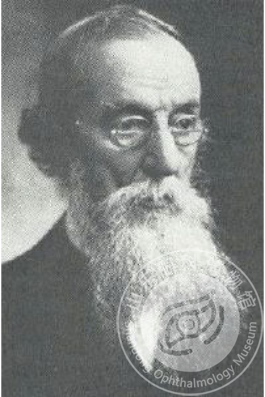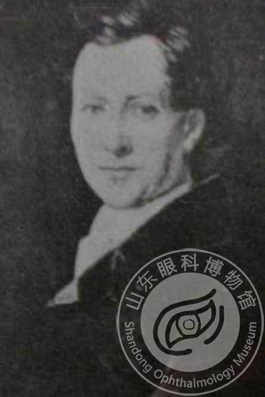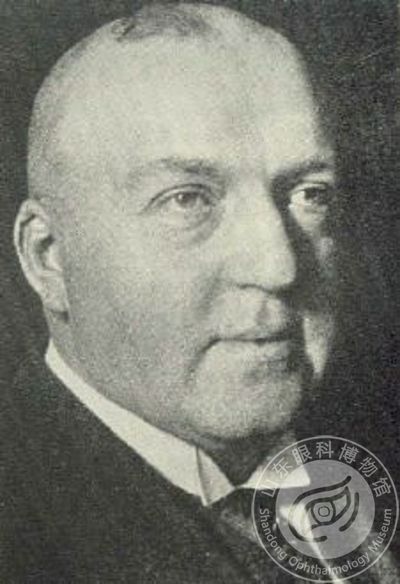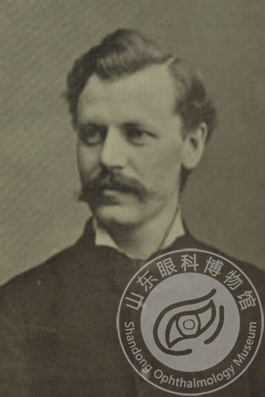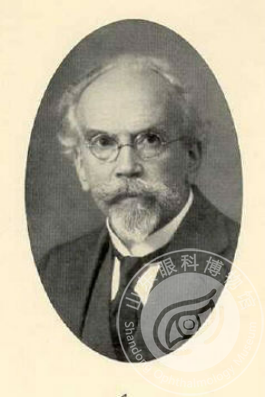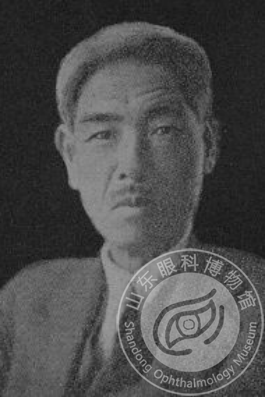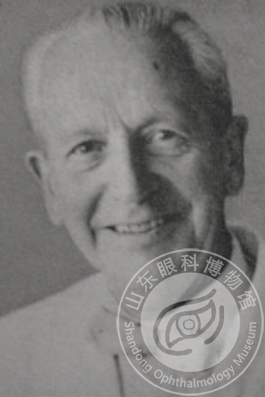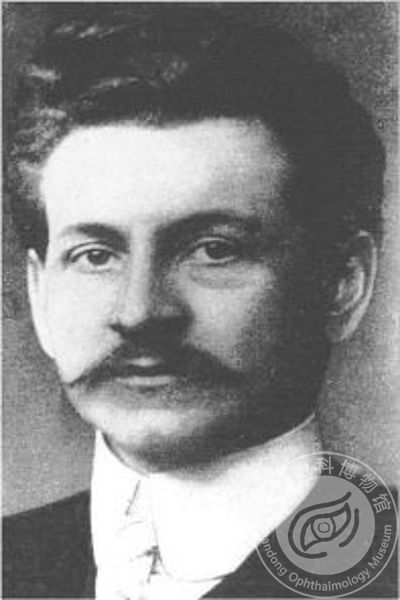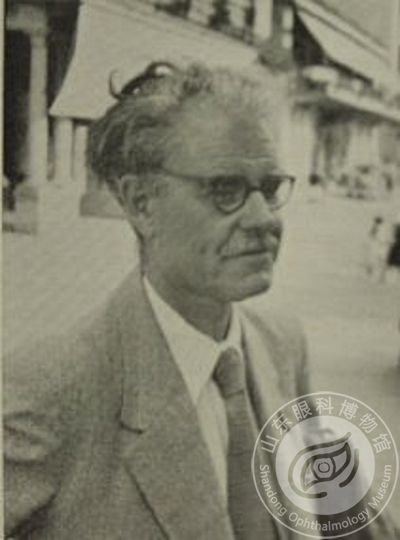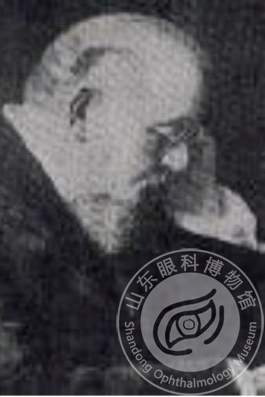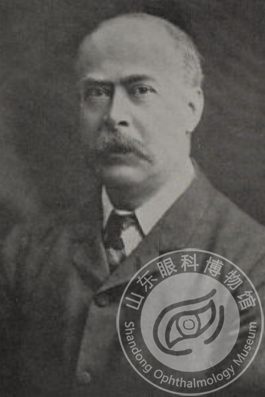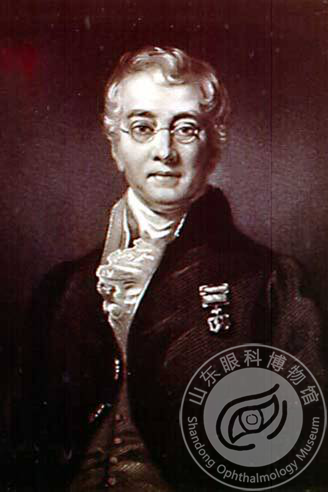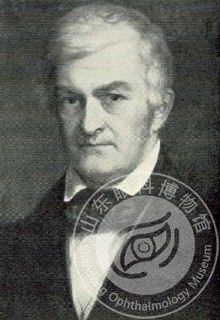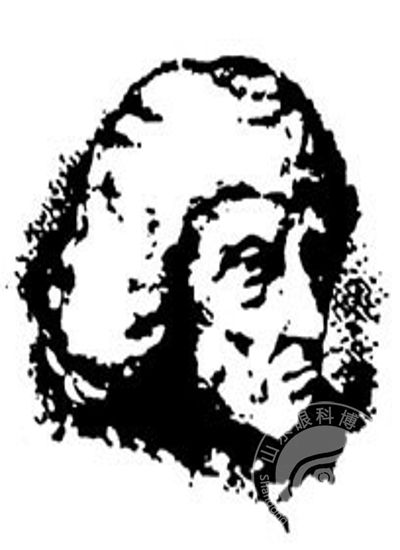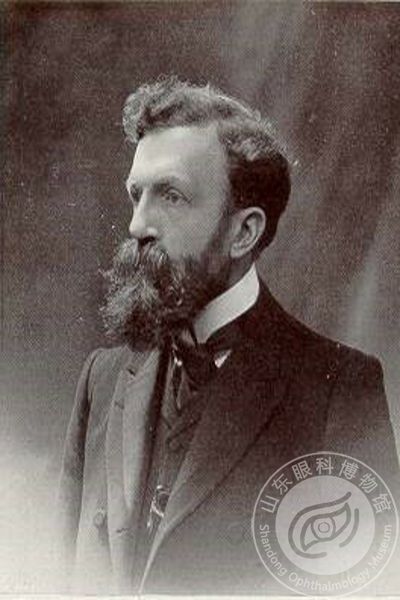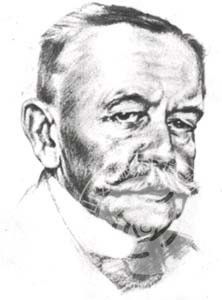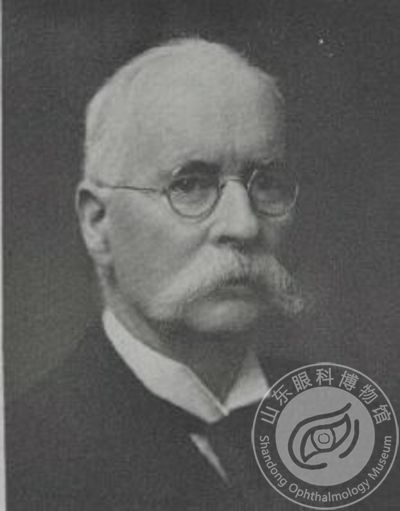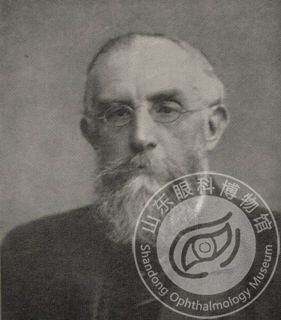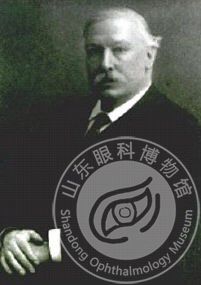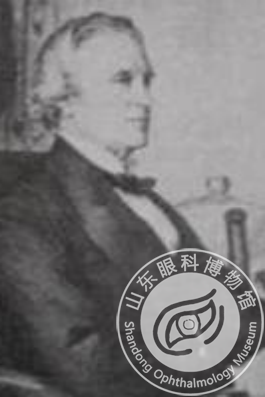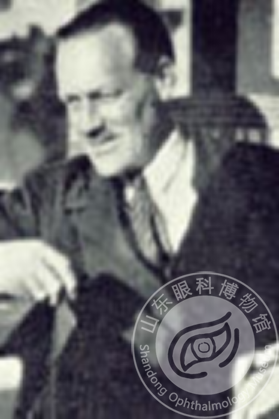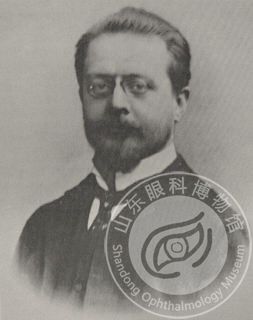British ophthalmologist, born in 1803, Norwich; May 2, 1852, died in London. John Dalrymple is the eldest son of Norwich's famous surgeon, William Dalrymple (1772-1847). He accepted his father's first medical education before entering the University of Edinburgh and graduated in medicine in 1827.
Dalrymple contributed to the ophthalmology literature in two large works published in 1834 and 1852. John Dalrymple played an important role in discovering the albumin now known as the Bence Jones protein. See Henry Bence Jones, British physician and chemist, 1813-1873.
Signs of Dalrymple: Hyperthyroidism (Barcelone's disease) when the eyelids widen or the eyelids, resulting in an abnormal width of the cleft palate.
Dr.Laurence (1829 - 1870), Ph.D., British ophthalmologist. In 1857 he became the founder of the South London Eye Hospital and later known as the Royal Eye Clinic. In 1864, he became the founder and editor of the "Ophthalmic Review" magazine, the first journal in the UK dedicated to ophthalmology. At the same time, he was praised for promoting the use of ophthalmoscopes in the UK. In 1866, along with his colleague Robert Charles Moon, a very rare complication of retinitis pigmentosa syndrome was described.
Laurence-Moon Syndrome: Loss of vision leads to blindness, mental retardation, short stature and hypogonadism.
Sir Hutchinson (1828-1913), British ophthalmologist and surgeon, syphilis specialist, neurologist, and a writer and teacher.
Hutchinson's contribution to the surgical profession and the advancement of natural science research is amazing. He has published more than 1,200 medical articles, which have strong observational effects on gout, leprosy and other diseases, and the pathogenesis of neuropathy. He is also an expert in syphilis. He also opened an educational museum for natural history education in his hometown of Selby. In 1908, he won the British Knight Medal.
Hutchinson's sign: notched incisors, labyrinth deafness and interstitial keratitis.
An anatomist in Paris; born in 1790 and died in 1883. Jules Germain Cloquet is the younger brother of Hippolyte Cloquet (1787-1840). He was originally an apprentice in his father's studio. He was a draftsman and later became a model for the anatomical figures of Paris teachers. He first studied natural sciences in Rouen, but came to Paris in 1810 to work on medicine.
Cloquet reformed theoretical education by using pictures and preparing for reform. His lecture was collected and published by Dominique-Jean Baron Larrey (1766-1842). In addition to numerous papers on surgery and anatomy, Cloquet is also considered to be the invention of several surgical instruments, including arterial forceps and devices for removing foreign objects.
Cloquet's tube: the residue of the embryo.
German ophthalmologist, born in Berlin on December 4, 1875;He died in Marlborough on April 2, 1927.Carl Bruno stagat was educated at the universities of Heidelberg, erlangen and Berlin and received his doctorate from keele university in 1899.Trained in ophthalmology by professor Carl walker (born 1836) in Kiel, he became assistant chief physician at the university eye clinic.He then worked at the eye clinic in Strasbourg and became the director of ophthalmology in Bonn.In 1923, he succeeded Max belsowski (1899-1940) as head of the department of ophthalmology at the university of marburg.Stargardt's disease: the most common adolescent form of macular degeneration, characterized by multiple yellow subretinal pistil lesions.
Krause (1797-1868), German anatomist. He received his doctorate in medicine from the University of Göttingen in 1818 and later received his anatomy chair at the School of Surgery in Hannover. His son Wilhelm Krause (1833-1910) is also an anatomist. Klaus was one of the first anatomists to use the microscope extensively. He was the first doctor to describe the perineal transverse ligament and described the accessory lacrimal gland of the eye.
Krause's glands: An accessory gland under the eyelid that meets the lower eyelid and upper eyelid.
Krause's ligament: Perineal transverse ligament.
German ophthalmologist, born on June 24, 1867, Medina in Asia Minor; on July 29, 1930, Freiburg im Breisgau died. Axenfeld has made important contributions to the anatomy of the eye, bacteriology and histology, and surgical ophthalmology. He is particularly interested in eye infections, and in Freiburg, his excellent clinical and laboratory facilities have enabled him to expand his research in the field. His eye care, his teaching and operational skills have attracted many graduate students, and Axenfeld has gained an international reputation. In 1925, he was elected chairman of the German Academy of Ophthalmology (Deutsche ophthalmologische Gesellschaft), who received the Graefe Medal for research on metastatic ophthalmia. He also received the Gold Award from the American Academy of Ophthalmology for his contribution to the profession.
Axenfeld syndrome: a syndrome characterized by a later corneal embryo toxin, a significant Schwalbe line and adhesion of the iris to the Schwalbe line.
Kobayashi Mitsu (1880-1954), Japanese eye scientist. Meiji was born in December of the 13th. Dazheng was a professor at Kyoto Medical School for 8 years and later became a professor of ophthalmology at the Northeast Imperial University (now Northeastern University). In 1929, an ocular anterior idiopathic uveitis with systemic symptoms was discovered and reported. He died on February 25, 29th.
Vogt-Koyanagi-Harada syndrome: sudden pigmentation, eyebrows and hair whitening, baldness and vitiligo and other skin damage, headache, dizziness, nausea and other nervous system manifestations, tinnitus, deafness and dizziness and other inner ear symptoms.
Swiss ophthalmologist, born in 1891, died in 1968. Marc Amsler is a student at Jules Gonin of the University of Lausanne and a representative of Gonin's idea of retinal detachment repair. He succeeded Gonin as a professor of ophthalmology at Lausanne in 1935 and became a professor at the University of Zurich in 1944. He is a pioneer in the study of uveitis aqueous humor and is interested in monitoring the symptoms of the macula in retinal diseases.
Amsler's sign: bleeding from applanation tonometry and cataract
Fuch's metachromatic iridocyclitis (FHI) surgery. It was once considered a feature of FHI and was previously used as a diagnostic and validation test for patients with suspected FHI.
Otto Schirmer (1864-1918) was born in greifswald. In 1896, after his father Rudolf Schirmer, he studied at the university of greifswald, the university of Munich, the university of freiburg, the university of konigsberg and the university of halle.His name is best remembered for his work on the lacrimal duct, including the elegant and simple lacrimal duct estimation test named after him (1903);He then published a paper on the microscopic anatomy and physiology of the tear system in the second edition of graf-samish hambuch, published in 1904.In 1909, he left Strasbourg and immigrated to New York, where he joined the New York graduate school of medicine, the hermann knapp memorial eye hospital, st. mark's hospital and the Bronx hospital.Schirmer test = this involves folding the sterile filter paper strips and inserting them between the lower cover and the sphere, about a third of the cover edge.The results are expressed as mm wetting at 5 min.If a local anesthetic is injected into the eye before the test is done, this is known as the basic Schirmer test
Dutch ophthalmologist and geneticist, born on June 3, 1886.He died in 1979.Following medical research at the university of Utrecht, Petrus Johannes Waardenburg received training in ophthalmology and a doctorate in his thesis on the genetic basis of the physiological and pathological characteristics of the eye.Genetic eye diseases are a particular area of interest to him.At the age of 66, he published a landmark two-volume book, the genetics of ophthalmology, with professor adolph franchitte (1896-1968) and professor David klein (1908-).Waardenburg syndrome: an inherited congenital defect that includes pigmentation, epicanthus and lateral shift of the lacrimal point, and deafness.
Robert Moon (1844-1914), an ophthalmologist working in medicine in the United Kingdom and the United States. He is the son of Dr. William Moon (1818-1894), the inventor of the blind embossed letter "moon type".
Robert Moon's career choices in ophthalmology were influenced by his youthful experience of helping his father translate and copy reading materials for the visually impaired. From 1866 to 1878, he practiced at the South London Eye Hospital, which was founded in 1857 by Dr. Laurence (1829-1870). Together with Dr. Lawrence, he named a disease characterized by retinitis pigmentosa and a variety of other symptoms.
Laurence-Moon Syndrome: Loss of vision leads to blindness, mental retardation, short stature and hypogonadism.
British ophthalmologist, born in 1857, died in 1916. Robert Walter Doyne was educated at Oxford, Bristol and St. George's Hospital in London and settled in Oxford in 1885. He is a very sensitive and accurate clinical observer, named after his transparent denaturation (Doyne's Cellular Crohn's cho) is just one of several situations he first described. Two years after his death, the establishment of the Doyne Memorial Lecture and Medal is also a concentrated expression of his imprisoned emotions, which remains one of the most precious differences in British ophthalmology.
Doyne Honeycomb Veinitis: In some families living in Oxford, England, the drusen present on Bruch's membrane was observed. These dendrites tend to fuse together and eventually fuse, just like a hive; therefore, Doyle's cellular choroiditis gets its name.
Seidel's test = a test which uses 2% sodium fluorescein to check for leaks such as post corneal trauma or post-trabeculectomy.
Scottish anatomist, surgeon and physiologist, born in November 1774; died on April 28, 1842 in North Harlow, Worcestershire. In England, he was considered the most important doctor and scientist at the time. During his visit to Paris, Professor Roux ended his speech with the words “C'est assez, Messieurs, vous avez vu Charles Bell”. There was a fascinating flash behind his glasses, he was very kind and unaffected. Famous doctors from all over the world came to visit him in London, and his travel abroad became a parade of victory. He received many honors, including the spirit of the Cavaliers, awarded by the lord Henry Peter Bloomham (1778-1868).
Bell's palsy: Peripheral, usually unilateral, facial nerve idiopathic paralysis.
Terrien's marginal degeneration = an uncommon but distinct variety of marginal thinning of the cornea. It is usually bilateral, although often asymmetric, and is seen mainly in younger men.
Uhtoff's phenomenon = Uthoff's phenomenon refers to visual problems that occur in persons with MS that are brought on during periods of increased body temperature. The usual history is of "black spots" appearing in the visual fields of one or both eyes while the person is exercising, in the sauna, taking a hot shower, or having a fever. This phenomenon is felt to reflect areas of impaired but still functioning myelin that breaks down in transmitting electrical impulses when the surrounding fluid heats up.
British ophthalmologist and surgeon, born 1843;Died on May 15, 1927, in Croydon.Warren Tay, from Yorkshire, studied medicine at a London hospital.In 1868, he was appointed assistant surgeon at the blackfriars hospital of dermatology, where he remained until 1907.He also had a job at the north eastern Hospital for Children in hackney road, now Queen's Hospital for Children.In 1869 he became a member of the royal college of surgeons and was appointed assistant surgeon and ophthalmologist at the London hospital.Tay-Sachs disease = an autosomal recessive lysosomal disease characterized by retinal cherry red spots, neuronal degeneration, and usually early death before age 3.
British physician, born 1850, died 1919.In 1865, he was sent to a Quaker school in London.William entered Bristol medical school in 1868.He received his doctor of medicine in London in 1875.After serving as a physician's assistant, he became a resident and later registrar of the national hospital for paralysis and epilepsy.It was there that he laid the groundwork for an extensive and thorough investigation of neurological diseases.Sturg-weber syndrome: congenital disorder characterized by facial wine spots with intellectual disabilities and epilepsy.The incidence of glaucoma is high due to increased scleral pressure.
Bowman, the 1st Baron (July 20, 1816 - March 29, 1892) was a British surgeon, histologist and anatomist. He is best known for his research on various human organs using microscopes, but during his lifetime he pursued a successful career as an ophthalmologist. Bowman's earliest remarkable work was on the structure of the striated muscle. To this end, he was selected as an academician of the Royal Society in 1841. After completing his surgical training in 1844, Bowman practiced as an ophthalmologist at the Royal London Eye Hospital (after the Murphy Eye Hospital). In 1880, he founded the "Ophthalmology Society" and later became the Royal Academy of Ophthalmology.
Bowman Pouch, his name is named Anatomy.
British physician and neurologist, born 31st October, 1886, Geelong, Victoria, Australia; died 17th March, 1935.
William John Adie was born in the harbour city of Geelong, west of Melbourne on the southern coast of Australia. He received his first education at Flinder’s School, but at the age of 13 he had to leave school in order to support the family, as his father had died in 1899. He worked as an errand runner in an office. One of his employers recognised his capacity for learning and paid evening courses for him. Thus he was able to pass the examination necessary for university entry. One of his topics was German, which had had learned mostly from visiting sailors. It was a practician in his native city, Dr. Arthur South, who inspired Adie to embark on a medical career.Adie had great intellectual gifts and he was an acute clinical observer and a fine teacher. He was also a kindly, modest, approachable man and he was held in high regard by his students. He lived an active life and had many interests. In particular, he was a keen ornithologist and tennis player and he enjoyed skiing and skating during his holidays in Switzerland. His greatness and popularity is well mirrored in the numerous and extensive obituaries in British Medical Journal and Lancet, among many. In his native town the youth who had accomplished so much on the other side of the earth was not forgotten. The daily newspaper Geelon Advertiser wrote a long obituary under the title ”Geelong boy who made good in London.”
With his friend and mentor, James Collier Adie was responsible for the section on neurology in Price’s Textbook of Practical Medicine.
Flexner-Wintersteiner rosette = A feature of retinoblastoma when seen under microscope. It is thought to resemble a flower bud. The same rosette is also seen in pinealoma.
